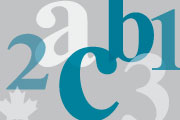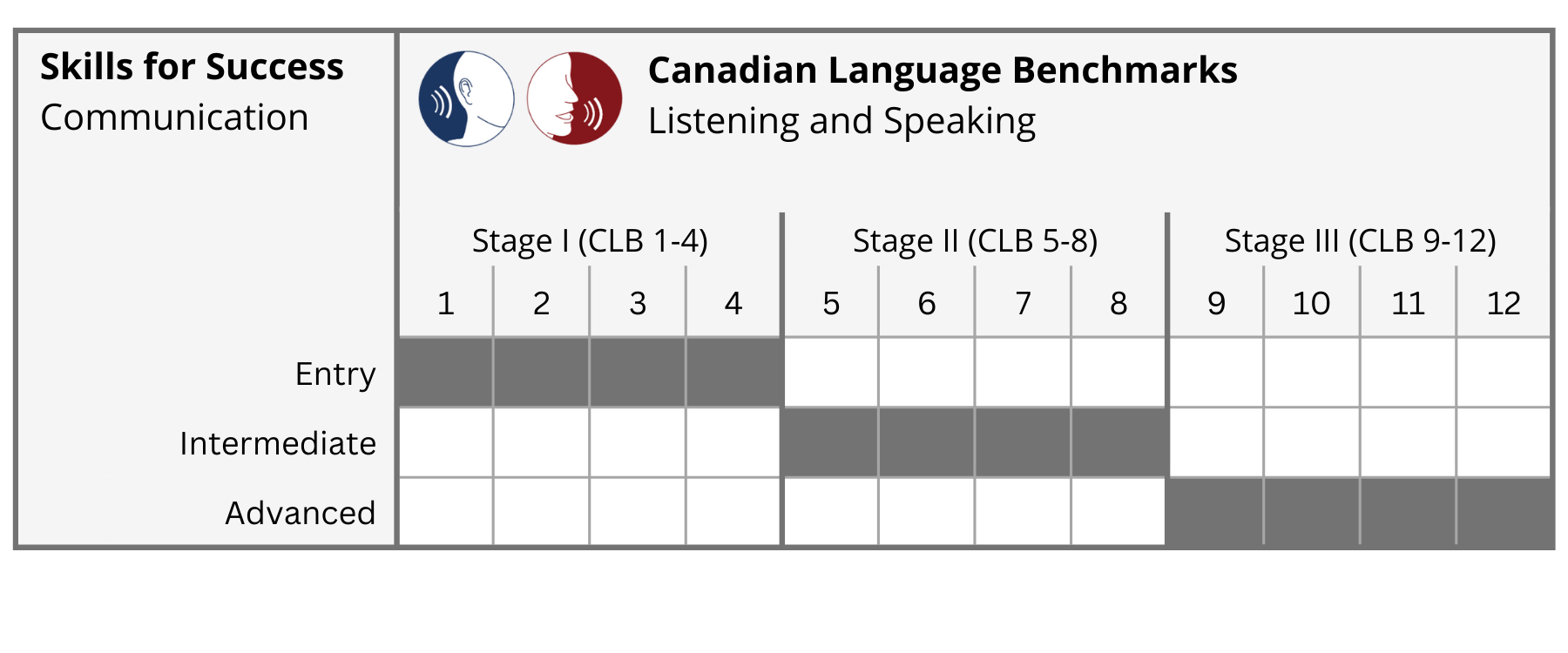Communication
Skills for Success defines Communication as the ability to receive, understand, consider, and share information and ideas through speaking, listening, and interacting with others.
See how SFS Communication relates to CLB Listening and Speaking
Skills for Success (SFS) is a national framework that identifies nine key skills Canadians need for work, learning and life. The Language for Success framework uses the SFS definitions and levels as conceptualized by the Government of Canada. The number of levels varies by skill. SFS Communication is organized into three proficiency levels: Entry, Intermediate and Advanced.
The Canadian Language Benchmarks (CLB) describe communicative ability in English as a Second Language (ESL). The CLB organize 12 benchmarks into three stages of ability: Stage I (Basic), Stage II (Intermediate) and Stage III (Advanced).
The shading in the table shows how the SFS Communication levels relate to the CLB Listening and Speaking benchmarks.
Explore what a person can do at each Listening and Speaking benchmark
CLB 1
Understand a limited number of simple and familiar words and phrases.
For example, at work:
-
Follow a very short direction when a gesture is used to support it. (The bathroom is over there. Take it upstairs.)
-
Recognize a request for attention. (Excuse me.)
-
Follow a simple command or instruction. (Please sit down.)
CLB 2
Understand some simple and familiar words, phrases and short sentences.
For example, at work:
-
Recognize a short request. (How do you spell your name?)
-
Understand a short simple safety warning. (Do not use the stairs.)
-
Follow simple spoken instructions. (Put the date here. Sign on this line.)
CLB 3
Understand short sentences and some simple questions about familiar, everyday topics.
For example, at work:
-
Understand a co-worker’s request to switch a shift.
-
Get the gist of a short simple announcement about a company event.
-
Follow spoken directions to a department or floor of a building.
CLB 4
Understand simple information and questions about familiar, everyday topics.
For example, at work:
-
Follow a short conversation about who will do a routine task.
-
Listen and respond to simple, casual small talk at work.
-
Follow instructions for a simple task, such as making a photocopy.
-
Follow a brief overview of topics to be covered in a training session, when accompanied by an aid (e.g., an agenda).
CLB 1
Greet people and give some simple information about themselves, using only a few words.
For example, at work:
-
Tell a co-worker your name.
-
Give a very simple short command or instruction. (Open the door.)
-
Ask for assistance by saying, "Please help me."
CLB 2
Greet people and give some simple information about themselves, using short sentences.
For example, at work:
-
Introduce yourself to a new co-worker and respond to their introduction.
-
Place a simple order. (Coffee with milk, please.)
-
Request to borrow an item from a co-worker.
-
Give a simple command or instruction. (Please don't answer the phone.)
CLB 3
Say a few simple sentences about familiar, everyday topics, needs and experiences.
For example, at work:
-
Greet a customer and exchange pleasantries.
-
Ask a supervisor for permission to leave early.
-
Ask simple questions to learn about a new co-worker.
-
Give simple directions to a new co-worker to help them find the lunchroom.
CLB 4
Give simple information about common everyday activities, experiences, needs and preferences.
For example, at work:
-
Initiate and maintain a brief small-talk conversation with a co-worker.
-
Leave a simple voicemail message for a supervisor to let them know you will be late.
-
Give a short set of instructions for a basic task such as how to clean a piece of equipment.
-
Provide an update to the supervisor on which routine tasks have been completed.
CLB 5
Understand with some effort the overall meaning, including some implied meanings when someone speaks about familiar topics.
For example, at work:
-
Listen to co-workers discuss their preferences for a meeting time and reasons for their preferences.
-
Listen to a voicemail message from a co-worker who is asking to switch shifts.
-
Follow instructions on how to use a piece of machinery.
-
Listen to an announcement with straightforward instructions for evacuating a building.
CLB 6
Follow the important details and understand some unfamiliar words, common idioms, and implied meanings when someone speaks about familiar topics.
For example, at work:
-
Understand a short awareness video about basic safety procedures at work.
-
Understand routine questions from a customer about a product in order to provide information.
-
Listen to a supervisor give instructions over the phone.
CLB 7
Understand the main points, important details and implied meanings when others talk about familiar topics and some abstract concepts related to general knowledge and life experience.
For example, at work:
-
Listen to a discussion amongst co-workers about a new policy, and understand the attitudes of the speakers.
-
Understand a safety expert describe how to handle a new dangerous material at work to determine appropriate actions.
-
Listen to a supplier’s response to a question about a product’s uses and availability.
-
Listen to a work status update from a co-worker during a shift change.
CLB 8
Understand the main points, details, purpose, attitude and implied meanings when others talk about familiar topics and a range of abstract concepts related to general knowledge, life experience and work-related situations.
For example, at work:
-
Listen to a customer describe their needs to identify a suitable service to offer.
-
Follow instructions from a help line or a video tutorial to fix a problem with equipment.
-
Participate in a performance review to identify strengths and areas for improvement.
-
Listen to a voicemail message from a dissatisfied client to understand concerns and identify a way to address them.
CLB 5
Communicate in short, routine social and work situations, using some longer sentences.
For example, at work:
-
Respond to a routine request from a customer on the phone.
-
Make a simple suggestion for how to improve sales on days of the week when business tends to be slower.
-
Place an order for goods with a supplier.
CLB 6
Communicate in everyday situations using some complex sentence structures to connect ideas.
For example, at work:
-
Apologize for arriving late to a team meeting and provide an explanation.
-
Decline an invitation to a team-building social activity and provide a reason you cannot attend.
-
Talk to co-workers to coordinate the use of equipment.
CLB 7
Speak comfortably on many familiar topics, including expressing opinions, feelings and reservations, and making detailed comparisons.
For example, at work:
-
Speak to a supervisor about dissatisfaction with a work schedule.
-
Give instructions to a new co-worker on options available if a customer wants to return a product.
-
Give a detailed suggestion for how to solve a problem or make an improvement.
-
Participate in a union meeting to discuss working conditions.
CLB 8
Speak comfortably about a range of topics, providing descriptions, opinions and explanations, and recommending solutions to problems.
For example, at work:
-
Clarify the terms of a job offer.
-
Mentor a junior team member by offering encouragement and constructive criticism supported by positive body language.
-
Respond to a customer complaint with empathy and reassure them that their needs will be addressed.
-
Lead a brief weekly staff meeting to provide information about goals and priorities.
CLB 9
Understand an adequate range of complex formal and informal communication on a broad variety of general interest topics, and on some specialized topics in own field.
For example, at work:
-
Watch a recording from a web-based meeting to prepare meeting minutes.
-
Listen to a panel discussion to identify ways of modifying the work environment to meet the needs of individuals with disabilities.
-
Listen to co-workers discuss how to address job vacancies during a meeting to identify opinions, strengths and limitations.
-
Listen to detailed instructions and requests for information from police, fire department and medical staff during a workplace incident.
CLB 10
Understand an expanding range of complex, formal and informal communication, across a range of situations and contexts that may require significant interpretation.
For example, at work:
-
Listen to a candidate’s responses to interview questions to evaluate suitability for the job.
-
Listen to detailed descriptions of multiple equipment failures over time to identify the root cause and possible solutions.
-
Listen to and evaluate a presentation delivered by a potential consultant outlining how they propose to solve a procedural issue.
CLB 11
Understand an expanded range of complex, formal and informal communication across a range of situations and contexts that may require significant interpretation.
For example, at work:
-
Listen to a co-worker recount a conflict with a manager and identify the attitudes and behaviours that contributed to the conflict.
-
Listen to a lecture presenting research findings at a professional conference.
-
Listen to focus group participants’ responses to understand and analyze views on a complex social issue and identify ways to probe for additional insights.
-
Listen to a variety of professionals giving assessments of a proposed large-scale equipment purchase, including a cost-benefit analysis and projected impacts on the workforce, to decide whether to proceed.
CLB 12
Understand an extensive range of complex, abstract formal and informal communication across a range of situations and contexts that may require significant interpretation.
For example, at work:
-
Listen to and critically evaluate the organization and delivery of a workplace training program to make suggestions for improvement.
-
Attend a public consultation to understand citizens’ views on a contentious matter.
-
Actively listen to an employee describe a serious workplace conflict, recognizing verbal and non-verbal signs of anxiety, anger and other emotions to validate their feelings and determine next steps.
-
Listen to a workplace mediator and the testimony of two parties to help them come to a mutually acceptable agreement.
CLB 9
Speak with some confidence in situations that require diplomacy, tact and precision, and present information about complex, abstract and general topics.
For example, at work:
-
Provide detailed instructions to a client over the phone to resolve a technical issue.
-
Co-facilitate a staff meeting, clarifying information as needed and ensuring that everyone has an opportunity to contribute.
-
Discuss a new project with a recently established team to identify activities, timelines and task assignments.
-
Make a presentation to co-workers to share the results of a survey and provide evidence to support a set of recommendations.
CLB 10
Speak with increasing confidence in situations that require diplomacy, tact and precision, and present information about complex, abstract and general topics.
For example, at work:
-
Respond appropriately to sarcastic or patronizing remarks from others in a meeting.
-
Present skills, abilities and experience in an interview, fielding questions with detailed responses to convince the panel of your suitability for the job.
-
Deliver training to co-workers on a new practice or procedure.
CLB 11
Speak comfortably in situations that require diplomacy, tact and precision, and present information about complex, abstract and general and specialized topics.
For example, at work:
-
Negotiate a long-term, large-scale agreement with a vendor.
-
Make an extended, formal presentation to a board of directors to propose a major change in an organization’s direction.
-
Lead a problem-solving session with an interdisciplinary team of professionals who bring diverse perspectives.
CLB 12
Speak with confidence in situations that require diplomacy, tact and precision, and present information about complex, abstract and general and specialized topics.
For example, at work:
-
Mediate a dispute between management and a bargaining unit.
-
Answer questions posed by the media during a live television interview in a situation where responses must be carefully worded to avoid controversy.
-
Present and defend research findings at a professional conference where attendees are likely to offer critiques.











